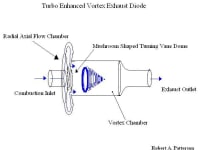Liberator
Turbo Enhanced Intake/ Exhaust V-diodes
Innovation pertains to enhancement tuning of intake and exhaust systems while improving fuel economy for combustion engines utilizing multi-cyclonic vortex action. Additionally, performance of the vehicle is enhanced while reducing particulate contaminates associated with the burning of fossil fuels.
The vortex phenomenon of interest occurs when both radial and axial flows are combined note these are the push and pull forces of a gaseous media in flow. Innovation functions similarly to its turbo-charging counterpart the modern turbo found on most sport vehicle applications; albeit the exhaust diode requires no moving parts conversely an intake diode might utilize a 50-thousand rpm fan motor attached to and electrically activated by the vehicles accelerator peddle.
The diode functions by passing exhaust gases radially into a pinched venturei pipe where the exhaust gasses get rerouted axially, which then pass into a vortex chamber through nozzles or swirl vanes before existing the exhaust system.
The intake diode functions similarly although it utilizes a fan and motor to activate and enhance the vortex action via the amount of air throughput into the combustion chambers thereby increasing both performance and fuel efficiencies.
The basic idea is to rotate the air or exhaust gases into a vortex so that by volume of the rotating mass you can increase the throughput and thus the efficiencies of the vehicle are improved.
Vortex-Diode History
Vortex chambers regulate throughput of water and liquids from raw sewage too spray atomizers, oscillators, onboard trains to chill drinking water, measuring wind speed. Vortex chambers comprise cylindrically shaped canisters having tangential, (angular) inlets.
Accelerated energy is converted when vortex flow exits the chamber. The most effective vortex chambers have an average throughput or (outflow) of up to 5-times more than narrow outlets alone.
Types of vortex motion “free vortex” increasing tangential velocity nearing center, to solid body rotation “forced vortex” recognized by Leonardo da Vinci as early as 1452.
George Ranque French physics 1928 while experimenting with vortex pump notices warm air exciting from one end of the tube and cold air coming out of the opposite end.
Early reports 1929 “Vortex Diode” R. Heim investigating performance of vortex diodes operating on water, and ignored by succeeding annalists, Heim witnessed non-linear effects such as reverse flow and large void in the center of the vortex revolving within the chamber. Ranque’s tube slips into obscurity until 1945 when German physicist Rudolph Hilsch publishes a scientific paper concerning the device.
After years of studying vortex control devices I came to realize that their basic make up modeled that of turbo charging criteria so combining vortex control devices together with turbo charging concepts seemed to be the next logical step in the evolution of increasing fuel efficiencies of combustion engines.
Crude prototypes of each diode have been fabricated and fitted into both intake and exhaust systems of test vehicles comprising V8 / 4-cyl. engines. Independent testing conducted by others yielded gains ranging from six, eight and ten mpg!
Like this entry?
-
About the Entrant
- Name:Robert Patterson
- Type of entry:individual
- Patent status:none





